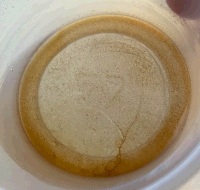SnailsAttack
Hazard to Others
  
Posts: 163
Registered: 7-2-2022
Location: The bottom of Lake Ontario
Member Is Offline
|
|
Fluorophosphate electrolyte questions
I've read that the electrolyte salt in lithium-ion batteries is some exotic crap called lithium fluorophosphate (LiPF₆).

Physically, the electrolyte is an unremarkable, brown, rank-smelling material which is alkaline and soluble in water but doesn't properly crystallize.
Most of the smell diminishes over time as the volatile components (primarily organic carbonates) evaporate.
I've found that an 11.98 gram cobalt-based lithium ion battery contains 0.74 grams of involatile electrolyte (picture above). The volatile components
of the electrolyte (which I lost to the air) were estimated at an additional 1.24 grams.
I'm not sure how much of what I've got is the lithium fluorophosphate salt. The material I have is enough to experiment with, but I figured I'd
consult the forum before messing with a fluorine compound.
Several hours of research turned up the following notes.
| Quote: | The non-volatile component of the electrolyte is probably composed of ethylene carbonate and propylene carbonate, which both boil around 240°C. All
other components documented online boil below 130°C except for the fluorophosphate salt.
Aqueous lithium fluorophosphate purportedly hydrolyzes to lithium fluoride, phosphoric acid and hydrofluoric acid beginning at temperatures above
70°C
LiPF₆(aq) + 4H₂O(l) -> LiF(aq/s) + H₃PO₄(aq) + 5HF(aq)
Dry lithium fluorophosphate is purportedly stable up to ~100°C, above which it decomposes to lithium fluoride and phosphorus pentafluoride gas.
LiPF₆(s) -> LiF(s) + PF₅(g)
PF₅(g) + 4H₂O(v) -> H₃PO₄(s) + 5HF(g)
Notes:
- Phosphoryl fluoride (POF₃) and various fluorinated derivatives of phosphoric acid are likely present as intermediates in the hydrolysis reactions.
- Lithium fluoride has a solubility of only 1.34 g/L in water at 25°C.
- Fluorine gases are very toxic and can cause acute lung damage.
|
Seeing as lithium and fluorine are relatively exotic I'd like to be able to isolate them. Do you guys have any ideas on how I'd go about doing that,
safely?
It might be possible to react the lithium fluorophosphate with sodium hydroxide to precipitate some (relatively insoluble) sodium fluoride, but I
don't really know how fluorophosphate salts behave.
|
|
|
SnailsAttack
Hazard to Others
  
Posts: 163
Registered: 7-2-2022
Location: The bottom of Lake Ontario
Member Is Offline
|
|
On a side note, the extraction of lithium and cobalt from the electrodes is going well and I'll probably document the process once I get it nailed
down.
|
|
|
blogfast25
International Hazard
    
Posts: 10562
Registered: 3-2-2008
Location: Neverland
Member Is Offline
Mood: No Mood
|
|
Be very careful with this salt: unstable fluorides are no joke!
I would pull a vacuum on the LiPF6/organics solution, to lower the BP of the carbonate solvents and evaporate them at low temperature..
BTW: HPF6 is a strong Bronsted acid, so its salts should react neutrally.
|
|
|
clearly_not_atara
International Hazard
    
Posts: 2692
Registered: 3-11-2013
Member Is Offline
Mood: Big
|
|
KPF6 has a low aqueous solubility of 3.5% w/w at 0 C. Could be useful.
https://pubs.acs.org/doi/pdf/10.1021/ja01629a031
Who wants to tell him? 
[Edited on 04-20-1969 by clearly_not_atara]
|
|
|
SnailsAttack
Hazard to Others
  
Posts: 163
Registered: 7-2-2022
Location: The bottom of Lake Ontario
Member Is Offline
|
|
Quote: Originally posted by blogfast25  | | I would pull a vacuum on the LiPF6/organics solution, to lower the BP of the carbonate solvents and evaporate them at low temperature..
|
Good suggestion, but I don't have the equipment. Also, the brown water-soluble impurity most likely isn't
volatile.
ah nuts
That is useful. thanks.
|
|
|
SnailsAttack
Hazard to Others
  
Posts: 163
Registered: 7-2-2022
Location: The bottom of Lake Ontario
Member Is Offline
|
|
Ultimately I was unable to obtain anything of interest from the ~2.0 grams of lithium-ion battery electrolyte. The fluorophosphate, however much there
may've been, didn't seem inclined to precipitate by adding potassium or calcium salts.
I didn't try to recover the lithium; most of what's in the batteries is likely bound up in the electrodes as lithium-cobalt oxide.
| Quote: | | On a side note, the extraction of lithium and cobalt from the electrodes is going well and I'll probably document the process once I get it nailed
down. |
Still working on this.
|
|
|